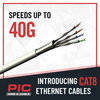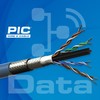Cable Carriers
(136 companies)
Cable carriers are constructed of flexible links and are used to organize and manage cables and hoses for moving applications.
Flat Cables
(318 companies)
Flat cables are used in computers for internal connections to peripherals. They consist of highly stranded, individually-insulated conductors that are laid parallel and then fused in a flat, flexible ribbon form. Flat cables are also referred to as ribbon cables.
Ethernet Cables
(334 companies)
Ethernet cables are designed to support Ethernet, a standard protocol for the connection of computers in a local area network (LAN). They use twisted pair cables and modular connectors, and are designed to run at 10 Mbps, 100 Mbps, or 1 Gbps.
Video Cables
(403 companies)
Video cables are used for the transmission of video signals, including monochrome, composite and component color video signals.
Fiber Optic Cables
(956 companies)
Fiber optic cables are composed of one or more transparent optical fibers enclosed in protective coverings and strength members. Fiber optic cables are used to transmit "light " data.
Cable Testers
(251 companies)
Cable testers are handheld or benchtop electronic devices that measure the electrical and physical properties of network cabling.
Computer Cables
(301 companies)
Computer cables are used to connect monitors, keyboards, printers, hard drives, and other peripherals to computers.
USB Cables
(239 companies)
USB cables are designed specifically to connect devices that use the universal serial bus (USB) protocol. They are used to connect personal computers (PCs) and peripherals such as mice, keyboards, printers, digital cameras, and mass storage devices. USB cables are also used in factory environments, sometimes with a locking mechanism, for connecting USB industrial I/O devices to computers.
Multiconductor Cables
(699 companies)
Multiconductor cables contain two or more conductors. Each conductor consists of a single wire or a combination of wires.
Serial Cables
(311 companies)
Serial cables are used for the serial transmission of data. They support communication standards such as RS232, RS422, and RS485, as well as Fibre Channel, IEEE 1394 or FireWire (R) (Apple Computer, Inc.), and universal serial bus (USB).
SCSI Cables
(153 companies)
SCSI cables are used for high-speed bus connections between small computers and intelligent peripherals such as hard disks, printers, and optical disks.
Audio Cables
(297 companies)
Audio cables transmit audible signals such as voice and music. They are designed to minimize noise and interference that can impair sound quality. Audio cables connect an audio source such as a stereo or microphone to an audio receiver or output such as speakers. Most products are shielded to prevent electromagnetic interference (EMI), typically with a foil and/or braided shield.
Network Cables
(703 companies)
Network cables are used in the transmission of data across networks. Choices include Fibre Channel, FireWire or IEEE 1394, GPIB, serial, parallel, patch, SCSI, Ethernet and USB.
Wire Rope and Mechanical Cable
(396 companies)
Wire rope and mechanical cable is wound from high-strength metal strands for structural, mechanical actuation and motion control applications.
Cable and Electrical Tapes
(234 companies)
Cable and electrical tapes are a variety of pressure-adhering adhesive tape specifically designed to wrap, shield, mask, mark, or insulate types of electrical cables, wiring harnesses, electric components, or circuit boards. Electric tapes come in many colors and materials, but black, vinyl tape has become the consumer standard.


